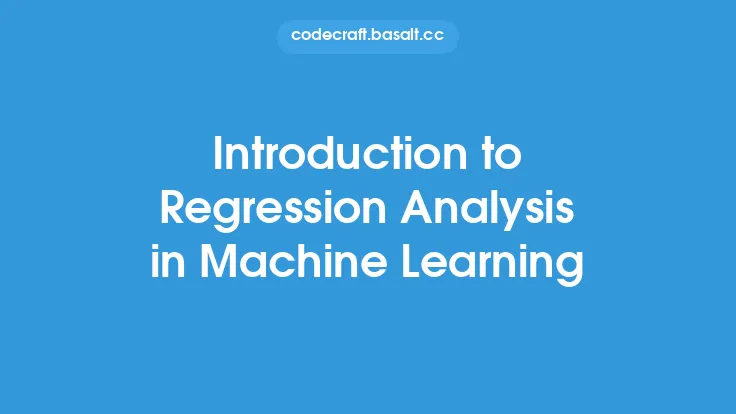Regression analysis is a fundamental concept in machine learning, and it has numerous applications in predictive modeling. Among the various regression techniques, Ridge and Lasso regression are two popular methods used to improve the performance of linear regression models. In this article, we will delve into the details of Ridge and Lasso regression, exploring their strengths, weaknesses, and differences.
Introduction to Ridge Regression
Ridge regression, also known as Tikhonov regularization, is a technique used to reduce the impact of multicollinearity in linear regression models. Multicollinearity occurs when two or more predictor variables are highly correlated, leading to unstable estimates of the regression coefficients. Ridge regression addresses this issue by adding a penalty term to the cost function, which shrinks the coefficients towards zero. The penalty term is proportional to the magnitude of the coefficients, and it is controlled by a hyperparameter, usually denoted as α. The Ridge regression model can be represented as:
y = β0 + β1x1 + β2x2 + … + βnxn + ε
where y is the response variable, x1, x2, …, xn are the predictor variables, β0, β1, β2, …, βn are the regression coefficients, and ε is the error term. The cost function for Ridge regression is given by:
J(β) = (y - Xβ)^T (y - Xβ) + α β^T β
where X is the design matrix, β is the vector of regression coefficients, and α is the hyperparameter.
Introduction to Lasso Regression
Lasso regression, also known as Least Absolute Shrinkage and Selection Operator, is another technique used to improve the performance of linear regression models. Lasso regression is similar to Ridge regression, but it uses a different penalty term. Instead of adding a penalty term proportional to the magnitude of the coefficients, Lasso regression adds a penalty term proportional to the absolute value of the coefficients. This leads to a sparse model, where some of the coefficients are set to zero. The Lasso regression model can be represented as:
y = β0 + β1x1 + β2x2 + … + βnxn + ε
where y is the response variable, x1, x2, …, xn are the predictor variables, β0, β1, β2, …, βn are the regression coefficients, and ε is the error term. The cost function for Lasso regression is given by:
J(β) = (y - Xβ)^T (y - Xβ) + α |β|
where X is the design matrix, β is the vector of regression coefficients, and α is the hyperparameter.
Comparison of Ridge and Lasso Regression
Ridge and Lasso regression are both used to improve the performance of linear regression models, but they have different strengths and weaknesses. Ridge regression is useful when there are multiple predictor variables that are highly correlated, and it reduces the impact of multicollinearity by shrinking the coefficients towards zero. Lasso regression, on the other hand, is useful when there are some predictor variables that are not relevant to the response variable, and it sets the coefficients of these variables to zero.
In terms of computational complexity, Ridge regression is generally faster than Lasso regression, especially for large datasets. This is because Ridge regression has a closed-form solution, whereas Lasso regression requires iterative algorithms to find the optimal solution.
Choosing Between Ridge and Lasso Regression
The choice between Ridge and Lasso regression depends on the specific problem and the characteristics of the data. If the goal is to reduce the impact of multicollinearity and improve the stability of the model, Ridge regression may be a better choice. If the goal is to select a subset of relevant predictor variables and reduce the dimensionality of the data, Lasso regression may be a better choice.
It's also important to consider the value of the hyperparameter α, which controls the amount of shrinkage in both Ridge and Lasso regression. A small value of α will result in less shrinkage, while a large value of α will result in more shrinkage. The optimal value of α can be determined using cross-validation techniques.
Hyperparameter Tuning
Hyperparameter tuning is an essential step in both Ridge and Lasso regression. The hyperparameter α controls the amount of shrinkage, and it needs to be tuned to achieve the best performance. There are several methods for hyperparameter tuning, including grid search, random search, and cross-validation.
Grid search involves trying out a range of values for α and selecting the one that results in the best performance. Random search involves trying out a random set of values for α and selecting the one that results in the best performance. Cross-validation involves splitting the data into training and testing sets and evaluating the performance of the model on the testing set.
Real-World Applications
Ridge and Lasso regression have numerous real-world applications, including:
- Predicting continuous outcomes, such as stock prices or energy consumption
- Selecting a subset of relevant predictor variables, such as genes or proteins
- Reducing the impact of multicollinearity, such as in econometric models
- Improving the stability of linear regression models, such as in financial modeling
Conclusion
Ridge and Lasso regression are two popular techniques used to improve the performance of linear regression models. While they share some similarities, they have different strengths and weaknesses. Ridge regression is useful for reducing the impact of multicollinearity, while Lasso regression is useful for selecting a subset of relevant predictor variables. The choice between Ridge and Lasso regression depends on the specific problem and the characteristics of the data. By understanding the differences between these two techniques and how to tune their hyperparameters, practitioners can improve the performance of their linear regression models and achieve better results in a wide range of applications.





